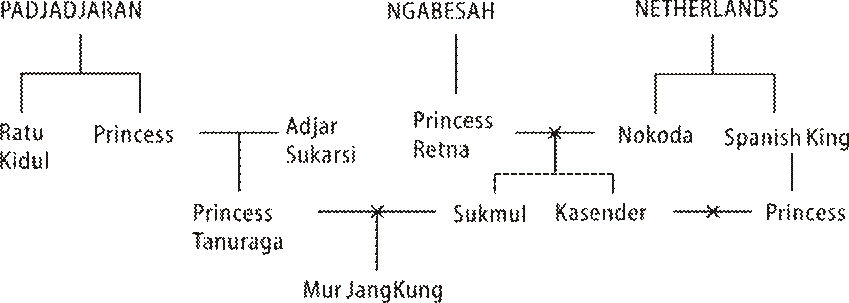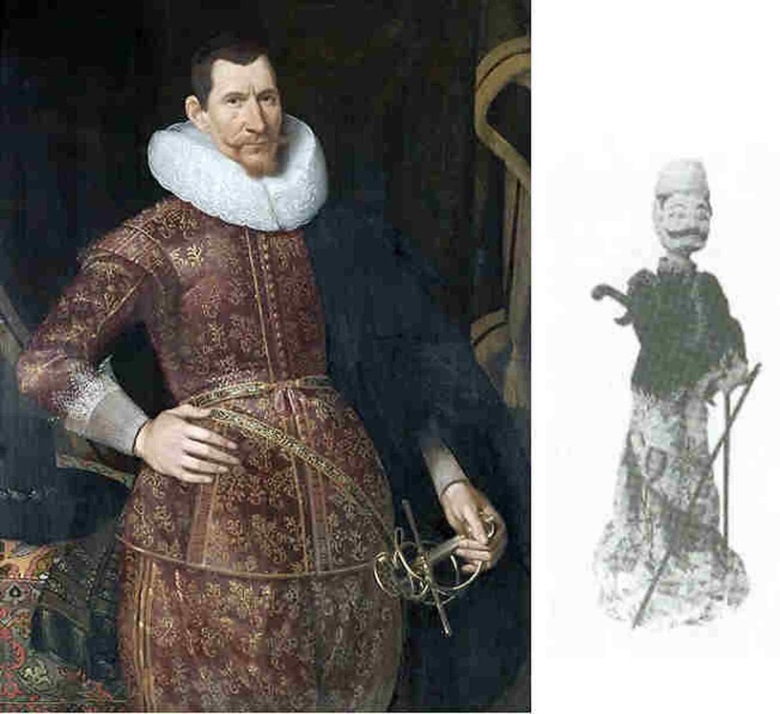
12. A tale of Mur Jangkung (from Chapter 1)
Although Jan Pieterszoon Coen who founded Batavia in 1621 was a pure Dutchman born in Hoorn in 1587, there is an interesting tradition. According to The Book of Baron Sakhender (Serat Baron Sakhender), written in the 18th century in Solo in the Javanese language in the form of a long poem, Coen was a man called Mur Jangkung born of a Pajajaran Princess, Tanuraga, and Baron Sukmul, a brother of Sakhender (Alexander) from Spain. Although accessing the original copy of its Dutch translation was difficult and citations in many articles were fragmental and ambiguous, a book[1] in which the story was explained in detail in English was available. The story of Mur Jangkung was written in the second part of the book.
“Probably in the middle of the 16th century when the Islamic power led by the Pangeran[2] of Jayakarta encroached on the territory of Pajajaran Kingdom, one of the princesses fled to a mountain, where she became pregnant by the Ajar Sukarsi[3] and gave birth to a daughter of surprising beauty, named Tanuraga. The Pangeran of Jayakarta abducted Tanuraga but could not sleep with her because flames emitted out of her genitalia. She was therefore deported to a small island, Pulau Putri [lit. Princess Island] in the Bay of Jakarta. The Sultans of Cirebon and Mataram in turn took her for themselves but neither of them was successful to possess her either, for the same reason. She was sent back to the island and lived there in sorrow.
“There, Sukmul came from Spain on board a trading ship and bought her for three pieces of cannons[4] and took her home. Sukmul and Tanuraga married and a son born between them was named Mur Jangkung. When Mur Jangkung grew up to be a famous warrior and heard about his origin, he decided to take revenge upon the Islamic princes who had disgraced his mother and ruined her country, Pajajaran, and sailed to Java with a fleet of fifteen warships. Although Mur Jangkung was well received not only by Dutch settlers but also the Pangeran of Jayakarta and mixed with the local people with Malay[5] which he had learnt from his mother, he was all the while making military preparation for his revenge. When a cannon ball accidentally fell in the ground of kraton [palace] during his practice, the Pangeran told him in anger to leave Jayakarta, but he begged a pardon saying that he would suffer a great commercial loss. It was the Pangeran himself who, in accordance with the will of God, moved to Gunung Sari [within the boundary of the present-day Jakarta] to get away from the Dutch and their cannon. Mur Jangkung was pleased at this and built a castle called Kuta Tai. The Dutch attacked the Pangeran, but the war situation became deadlocked, as the Pangeran’s younger brother, Purbaja, a warrior with a supernatural power, joined the enemy. Sukmul who heard of this in Spain came to Java and gave advice to his son. When coins were discharged, instead of cannon balls, towards Gunung Sari, the soldiers of Jayakarta ran out to pick up the money. Then, real cannon balls were shot to fell them down. By the will of God, filled with fear, the Pangeran of Jakarta retreated to the mountains to the south of Jakarta, but soon his troops left him. He became a mere rebel, practising asceticism with local people, with no hope to recover any lands. In great sorrow, he thought that he had once sold the daughter of Sukarsi and the Princess of Pajajaran was his error and, asking himself within his heart, ‘What is the will of God for my course of life?’, deplored that he would be punished by Sultan Agung of Mataram and die. The Dutchmen in Batavia grew even more, setting forth their designs to create a city surrounded by water. The River Ciliwung was incorporated in the city.”
In the above story, it is said that Mur Jangkung came not from Holland but Spain. It was because in the first part of the long poem in which the family line of Sukmul and the situation in Europe were described, Spain was placed under the control of Holland. The first governor of Holland was Nakoda (lit. Captain) who was born, cut out of the womb of his mother. Although he was an orphan, he became famous in battle and rich as a merchant, and took twelve daughters of twelve kings as wives. These wives were infertile, but when Nakoda went to the mountains and implored a hermit, Mintuna, for help, eleven of them became pregnant and gave birth to eleven sons, who all later became the board members of the company (VOC). The wife who did not have a baby at that time was Sang Retna (Princess Retna) of Ngabesah. She had been treated coldly by her husband and put to live apart in the cooking-place, but, after fourteen years, produced a sea-shell from which twin sons, Sukmul and Sakhender, appeared. After fourteen years, Sakhender was called by Mintuna to visit the latter’s hermitage. He was almost eaten by the hermit but managed to kill him. Sakhender went to Spain and, being entrusted by the king as a distinguished warrior, married the princess. Then, he won an important war[6]. The fact that the king of Spain was a long-separated brother of Nakoda was revealed and the throne was given to Sakhender. Although Spain prospered under the rule of Sakhender, after a while, Sakhender left Spain for Java where commerce was also excellent, handing over the throne to Sukmul. In Java, Sakhender became a vassal of the Sultan of Mataram.
The adventure of Sakhender was supported by the magical power of a demon king, Singgunkara, as well as several retainers, including Kaseber and Suhuruman, twin brothers born almost simultaneously from a mango-stone produced by his mother’s maid, a horse called Sumbrani, who was said to be a brother of Sakhender, and a bird called Garuda, who was said to be a brother of Kaseber. Indeed the story reminds us of some Arabian Nights.
A family tree such as below can be derived from the Book of Sakhender.

According to this genealogy[7], an assumption is possible that Mur Jangkung (or Jan Pieterszoon Coen) who had the blood of Pajajaran returned to his mother’s country rather than conquering Jayakarta. The time when this book was written was already 200 years since the Javanese had first encountered the Dutch and the former should have acquainted with right knowledge about European history. Why was such an unrealistic story created? The prime answer can be, “It was fiction.” As to the reason why the author wrote such an allegory that might justify the invasion of foreigners, there is an interpretation that it was not a matter of concern for Javanese (in Central and East Java), because the land of Sunda, or the west part of Java Island, was regarded to be a foreign land.[8] One could alternatively say that the idea of self-determination only evolved after the First World War as a political principle, proposed by the then American president, Woodrow Wilson, in the 20,000-year-long human history.

Left: A portrait of Jan Pieterszoon Coen.
Reproduced from: https://nl.wikipedia.org/wiki/Jan_Pieterszoon_Coen
Right: Wayang Golek Puppet of Mur Jangkung (Jan Coen)
Reproduced from: http://indonesia.elga.net.id/wayang/
[1] M. C. Ricklefs, Jogjakarta under Sultan Mangkubumi 1749–1792: A History of the Division of Java, Oxford University Press, London 1974.
[2] Pangeran=Prince or lord.
[3] A name, “Ajar Sukaresi”, appears in “Ciung Wanara”, one of the Sundanese traditional poems called Pantun Sunda, as the holy name of King Sang Permana Kusumah (Ciung Wanara’s father) after he became a hermit (See Chapter 4). The spelling is very similar, but whether he was the same person as “Ajar Sukarsi” is unknown to the present author.
[4] Guntur Geni, Ki Pamuk and Njai Setomi. They were transferred to Mataram (Solo), Banten and Cirebon, respectively, and became their regalia.
[5] The so-called Low Malay. It was a lingua franca around the archipelago and became the national language of Indonesia after her Independence.
[6] The enemy was somehow Ngabesah, the grandfather of Sukmul himself, who demanded a princess of Spain, allied with England, France, China, etc. In one speculation, Ngabesah was Abyssinia (Ethiopia).
[7] Footnote 1. Ratu Kidul, the descendant of Pajajaran on the left-hand side of the family tree, legendary Queen of the South Sea, has no bearing on the Book of Sakhender. Among various versions, a tradition said, “Dewi Srengenge, a daughter of Mundinglaya Wangi [Siliwangi] was expelled from the palace, when she suffered from a skin disease by the black magic of a witch employed by Dewi Mutiara, the second consort of the king, who had wished her son to be the heir. When Dewi Srengenge reached the southern coast [on the Indian Ocean] and bathed in the sea-water, her disease was healed and an exceeding beauty was bestowed. At the same time, she obtained a supernatural power and became Ratu Roro Kidul, or the Queen of the Southern Sea” (Argo Wikanjati, Kumpulan Kisah Nyata Hantu di 13 Kota, Penerbit Narasi 2010). According to Babad Tanah Jawi, compiled in 18th-century Java, Panembahan Senopati had exchanged marriage vows with Ratu Kidul and obtained power, and the same relation persisted with the successive kings of Mataram (Nancy K. Florida, Indonesia, No. 53, Apr. 1992 (pp. 20–32), published by: Southeast Asia Program Publications at Cornell University).
[8] E. g. Anthony Reid, Early Southeast Asian categorization of Europeans, in S. B. Schwartz (Ed.), Implicit Understandings, Cambridge University Press 1994.